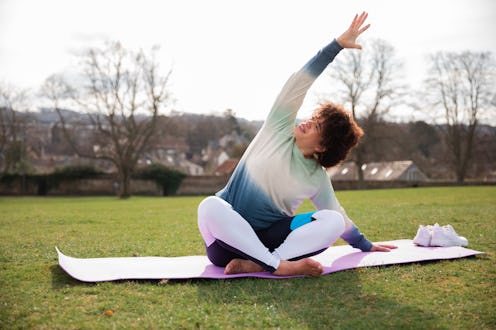Fitness
Trainers Say You *Should* Work Out When You’re Sore — Here’s Why
It’s more than just a flex.

The weather’s nice, you thought. You have some energy and cute new shorts and should go for a little run, you thought. Well, you went for that run, and even though you don’t quite regret it, your calves are so sore that you’re glued to the couch and you’re wondering if you should cancel your yoga class tomorrow morning. You were actually looking forward to your hour of sun salutations, but should you work out while you’re sore?
What Causes Post-Workout Soreness?
Exercise is supposed to make your body feel good, and in theory you want to go to more than one group fitness class a week. So why do you feel like you got hit by a truck and should never more again after spin class?
“The process of working out involves breaking down muscle tissue, commonly creating what is referred to as ‘microtears,’” says Kelsey Decker, a National Strength and Conditioning Association-certified personal trainer and the education coordinator for StretchLab. While hearing “tear” and “muscle” in the same sentence might sound bad, Decker tells Bustle that it’s actually just part of how your body gets stronger post-workout. “Soon after the workout ends, the muscle goes to work by repairing itself to form an enhanced version,” she explains. In other words, you’ll be able to spin faster another day — just, maybe not today.
How Will Soreness Impact Your Workout?
Pain from being sore after a workout is different than pain from an injury, says Weilin Wu, a NASM-certified personal trainer at Blink Fitness. “Normally, soreness can result in an aching and tender effect that lasts a few days, while the pain from an injury is typically acute and sharp around our joints and muscles,” Wu tells Bustle.
Wu explains that getting enough sleep, food, and gentle activity should make non-injury soreness go away within three to five days. But while you’re in that window, you’ll want to err on the side of caution when you choose your next exercises. “Being sore can limit your body's ability to reach full range of motion due to muscle tension and tightness,” Decker explains. “With a limited range of motion due to being sore, this can put you at a higher chance for injury.” So if your shoulders are sore from this weekend’s tennis match with friends (you actually served over the net!), today is probably not the day to try that upper body strength boot camp class at your gym.
Can You Work Out With Sore Muscles?
That said, trainers agree that working out carefully can help reduce your muscle soreness. “Increased blood flow through movement is key” to making your sore body feel better, Decker explains. It might feel stiff and uncomfortable to get started, but Decker says that activities as simple as going for a walk or practicing yoga can often help soothe your aching muscles in the moment.
“A workout can be tolerable if you’re targeting unaffected muscle groups or opt for an active recovery day where you’re doing low-impact cardio like elliptical, stationary biking, walking, or swimming to provide temporary relief with the extra blood flow to the muscles,” Wu explains. Taking 15 to 45 minutes to exercise while you’re sore can keep your momentum going for your workout routine and give you those endorphins all at the same time.
Experts:
Weilin Wu, NASM-certified personal trainer, Blink Fitness
Kelsey Decker, National Strength and Conditioning Association-certified personal trainer, education coordinator for StretchLab
This article was originally published on